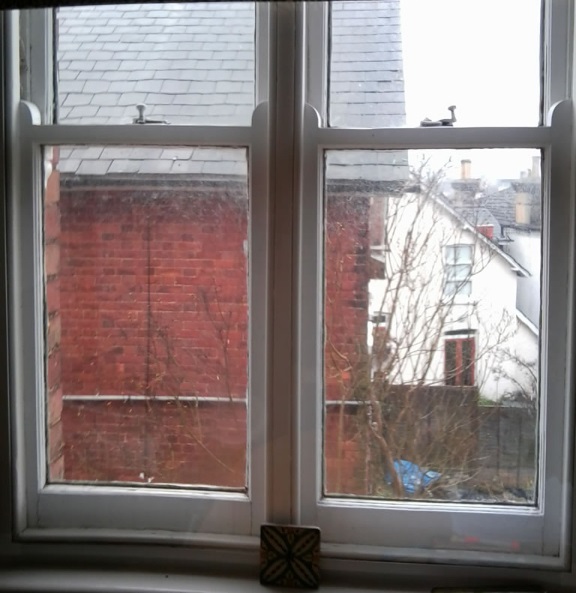
What is Double Glazing?
Double glazed windows use two sheets of glass with a gap between them that creates an insulating barrier. The gap can either be filled with a heavy inert gas such as Argon or it can be a vacuum; both of these act to slow the movement of heat from one side of the window to the other.
What is Secondary Glazing?
Secondary glazing involves installing supplementary glazing on the inside of an existing single-glazed window. It can be permanent, although often secondary glazing panels are added as a temporary measure.
Double-glazing is more expensive than secondary glazing
Double-glazing is considerably more expensive than secondary glazing, the reason being that if you decide to install double-glazing, you need entirely new units fitted – you cannot simply retrofit a second sheet of glass to single glazing.
In order for double-glazing windows to be effective thermal barriers, the gap between the panes of glass needs to be airtight and filled with an inert gas (or a vacuum). Hence for each window where you want double-glazing, a company will need to come around to your house and measure up and produce the windows specifically for you.
Secondary glazing is far cheaper – you can buy DIY kits or get installers to come and fit the supplementary glazing onto the inside of the existing window frame.
Secondary Glazing can be a DIY job; double glazing needs a professional!
As mentioned above the double-glazing units have to be made to order for your home, however once they have been built (when I had these installed it took about 6 weeks for them to be made), the installer can install about 3 windows per day. So the process is relatively quick, however this is certainly not a DIY project.
Installing secondary glazing can be done as a DIY job, however there are also companies out there that can come and install the secondary glazing for you. In comparison, since you don’t need to remove any existing window units to install secondary glazing, the process of installation is far simpler.
Which type of glazing is best to minimise heat loss?
One of the major reasons for replacing your existing windows with either double-glazing or secondary glazing is to increase the energy efficiency of your home – helping to reduce your energy bills. You will be glad to hear that both double-glazing and secondary glazing do an admirable job here. Double-glazing though is about twice as effective as secondary glazing at stopping heat escaping the home. If you swapped all your single glazed windows in an average three-bed home, you would save about £150 a year on your heating. Adding secondary glazing to the existing single glazing would save you about £75 a year. The uPVC double-glazing units should be good for 20 years or more, so payback is relatively slow, but you will get there eventually!
Secondary glazing provides a better level of acoustic insulation
Both types of windows are also great at cutting out noise pollution, however secondary glazing takes the winners medal here. Unlike the double-glazing sealed units, the two different pieces of glass in secondary glazing act as independent barriers to the transmission of noise. The greater the cavity between the two panes, the better the dampening effect – so double-glazing which has panes relatively close together is less good at cutting out noise.
Planning permission and double glazing = issues!
Planning permission is not normally required for repairing, fitting or replacing double glazed windows, except if the building is listed or in a conservation area, in which case you will run into problems, so speak to your local planning authority before installing anything.
A couple of tiny secondary glazing bugbears!
In my flat, I live on a busy road so have installed secondary glazing in my bedroom that backs onto this road, while in the rest of the flat I have had double-glazing installed.
There are two little issues I have had with my secondary glazing, firstly they are a pain to clean, because unlike double glazing where you simply clean inside and out, you actually need to clean 4 sides of glass, but reaching and cleaning the panes that back onto cavity are difficult to reach!
Secondly, my single glazed window is a sash window, and the secondary glazing unit slides to the side (this could be why cleaning it is so annoying). This means it is just a bit more fiddly to open them compared to opening my double glazing.
Ecoease Secondary Glazing
About 6 months ago we also came across Ecoease – these are easily removable secondary glazing panes made from PolyEthylene Terephthalate (PET) which is a recyclable plastic. This type of secondary glazing is growing in popularity since it is easy to install, helps prevent condensation, a fraction of the price of double glazing and easily removable (so you can take it off in the summer and put in back in place in the winter).
In the video below, James shows us how Ecoease is installed
If you are interested in finding out more about Ecoease secondary glazing, please visit them here.
So which is better – Secondary glazing or double glazing?
I have both types in my flat, and they both work really well – it has certainly made a difference to my heating bills since I had them all installed. My bedroom is almost entirely soundproofed from the busy road outside and the uPVC windows I had installed have really tidied up what was there previously. You may be forced into installing secondary glazing if you live in a listed property, but both types of glazing do a grand job, so I wholeheartedly recommend both of them!













What a wonderful article about double glazing vs secondary glazing. I think I will go with the double glazing option in the end. I have pretty old wooden sash windows and unfortunately I inherited most of them in pretty bad shape. I have been quoted high prices for the dg refurbishment option and in the end I am resigned to pay a little bit more for the full wooden units. At least then I can have them for a lifetime more.
Wonderful article here about double glazing v secondary glazing. Choosing the secondary glazing so that sound pollution is reduced! Thank you!
In your article you write that double glazing works because it’s filled with an inert gas or a vacuum.
Double glazing NEVER gets built with a vacuum between the glazing. This is because it would shatter. It is filled with inert gas.
you are incorrect, you can get double glazing that is 6mm thick in total that is vacuum filled that has micro spacers in it. its just very expensive
Good article, but your statement that ‘secondary glazing doesn’t need planning permission, even in a listed building’ is potentially very misleading and could land someone in hot water!
Whilst it’s true that you won’t need planning permission as you’re not undertaking any alterations to the exterior of the building, you will certainly require listed building consent for installing secondary glazing in a listed building.
You will generally need listed building consent for ANY alterations to a listed building regardless of whether they are internal or external. Whilst there may be some exceptions it’s generally safest to check with the local authority before doing work, as carrying out work to a listed building without consent can potentially be a criminal offence!
When carrying out work to a listed building, it is well worth seeking the advice of an architect or other suitably qualified professional if you are in any doubt at all about what you can or cannot do.
Thanks for that Chris – totally agree! Have amended the article accordingly.
Is it worth using secondary glazing on a double-glazed window (as it is not the best standard of double-glazing)?
Hi there. Probably not, no – it won’t make a huge difference on double glazing. For the amount it would cost, it might worth saving the money and putting it towards new secondary glazing, to be honest!
I have double glazing in all our windows but these are old wooden frame ones. Can secondary glazing make a difference on old double glazing? Can it be installed on wooden windows? What would the magnetic strip attach in this case?
Hi Lily. Secondary glazing is designed for single-glazed windows, and will not make a big enough difference on double glazing to justify spending the money. EcoEase secondary glazing can be used on wooden windows though – the magnetic strip is adhesive on one side, so sticks to any type of frame.
Is the gap significant for sound proofing and if so what is the max gap you can do for the best effect for sound proofing?
Hello, I’m looking for work in the field of double-glazed glass in the Netherlands. Help me. Thanks
I’d like to know why you don’t expand on this idea and add internal plus external panes where possible such as with wooden frames. This would improve insulation all the more surely.
Presumably one could find a source of the cheap plastic PET and DIY one’s own panes for almost negligible cost. Not sure if the article is for advertising the EcoEase only though.
Hi Anthony,
It’s certainly a possibility if you can find the right materials and have the skills to do it! If you’re able to make it work then we’d love to know how you get on and how the results compare.
Many thanks,
Harriet
This is a really great article, double glazing is definitely the way forward as it uses modern technology. It can usually be integrated with any type of window style but for security purposes I’d want to get an expert to fit mine!
Hi – am wondering if secondary glazing also keeps the heat out in a very hot environment? I believe that the sealed units do with the inert gas, but what about the secondary glazing with just a normal air gap? Thinking of a space with large shop sized windows in a very hot environment during the summer
Am curious to know why you don’t address the high cost to the environment through the manufacture of double-glazed units, particularly uPVC, added to the fact that, when they fail, they are not easily repaired, have to be disposed of and then release the gases into the atmosphere. Unfortunately, if you google double-glazing and environment, you’ll find lots of glazing companies telling you how good they are but without any mention of the true environmental cost. Timber-frames, although pricey, have a much longer life span and are carbon neutral.